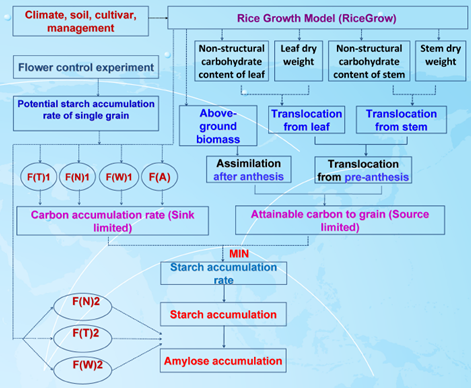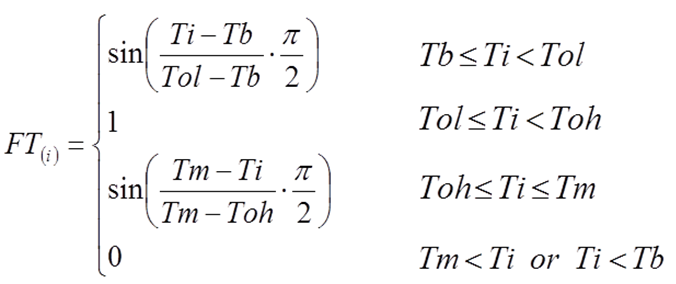Grain starch concentration represents the most important food energy source in the world (Pan et al., 2007). This carbohydrate is the main reserve compound of plants and it consists of two type of molecules: amylose, ranging from 0 to 33%, and amylopectin, varying from 77 to 100% (Suwannaporn et al., 2007).
The model available in the UNIMI.CropQuality component simulates the synthesis and accumulation of this molecule as affected by air temperature, nitrogen and water availability during the ripening period, other than as a function of the photosynthetic activity and translocation phenomena. The flowchart of all the processes involved in the model given by Chen (2011) is showed in Figure 1.

Figure 1. Theoretical flowchart of rice grain starch accumulation model.
In particular the relative starch content of individual grain is daily calculated as follow:

Where:
GCC(i) is the relative starch content of individual brown rice grain;
GSTA(i) is the individual grain starch accumulated (mg grain-1) on day i after flowering;
GDW(i) is the individual grain dry weight (mg grain-1).
The individual grain starch GSTA(i) is derived through the daily integration of individual grain starch accumulation rate restricted by source or by or by sink, which is calculated as follow:
![]()
Where:
GSTAR(i) (mg grain-1 day-1) is the daily rate of individual grain starch accumulation;
GCA(i) (mg grain-1 day-1) is the daily rate of available carbon restricted by source;
GSTARR(i) (mg grain-1 day-1) is the daily rate of available carbon restricted by sink.
The individual grain carbon accumulation rate sink limited is simulated considering possible genetic, meteorological and environmental limitations factors, according to the next equation:
![]()
Where:
GSTAR(m) (mg grain-1 day-1) is a parameter, specific for the simulated variety, describing the maximum daily rate of individual grain starch accumulation;
FA(i), FT(i), FW(i), FN(i) (unitless) are limiting facors ranging from 0 (higher impact) to 1 (no impact): they are related respectively to i) genetic ability for starch synthesis, ii) average air temperature after the flowering date, iii) water stress status and iv) nitrogen stress status of crop.
In the current version of UNIMI.CropQuality component the water and nitrogen stress status come as external rates variables from the crop models linked to the starch model, whereas the starch ability and air temperature factors are calculated consistently with the next two equations:

Where:
FA(i) (unitless) is the factor describing the ability of simulated crop for the starch synthesis;
GDD(i) (°C day-1) are the growing degree days accumulated after flowering date;
410 (°C day-1) is the threshold of growing degree days, identified by developers, at which the rate of grain filling reach the max value.

Where:
FT(i), (unitless) is the factor describing the effect of air temperature on starch synthesis during ripening period;
T(b) T(m) (°C) are the minimum and maximum temperature bounds for starch synthesis;
T(ol) T(oh) (°C) are the lower and higher temperature thresholds for optimal starch synthesis;
T(i) (°C) is the average daily temperature.
Instead the individual grain carbon accumulation rate source limited is simulated via the following algorithm:

Where:
GCP(i) (g m-2) is the daily carbon assimilation in the grains due to photosynthetic activity on day i after flowering;
GCT(i) (g m-2) is the daily carbon remobilization from vegetative organs on day i after flowering;
GN(i) (grain m-2) is the number of grains per square meter.
The GCP(i) is an external rate variable from the crop model linked with the starch module, whereas the grain numbers is calculated as function of GCP(i) and the single grain weight.
Then the total carbon daily remobilized from vegetative organs (GCT(i)) is calculated through the following equation:

Where:
GDD(m) (GDD day) is a parameter describing the growing degree days after flowering at which the remobilization of stored assimilates begins;
CTL(i) (g m-2) is the total carbon remobilized after anthesis from leaves;
CTS(i) (g m-2) is the total carbon remobilized after anthesis from stems.
Both CTL(i) and CTS(i) are derived daily by multiplying the leaves and stems biomass by its relative fraction of solubles sugars. These fractions of carbohydrates are calculated respectively through a linear and a quadratic function of growing degree days accumulated from sowing date.
Created with the Personal Edition of HelpNDoc: Free Web Help generator